The High Value of Low-Tech Classes
By Rebecca GoldfineThis summer we are launching a series about the humanities, examining why Bowdoin faculty are committed to teaching literature, languages, the arts, history, philosophy, and religion—and how students benefit.
“The Humanities Are in Crisis,” a 2018 headline in The Atlantic warns. A 2023 New Yorker article questions, “Enrollment in the humanities is in free fall at colleges around the country. What happened?”
It's like an unfortunate trope nowadays—one digested and repeated by many—that studying the humanities is a waste of time in a world driven by advancements in technology and science.
But Bowdoin faculty and administrators are adamant: The humanities do matter. They've always mattered, and they will continue to matter, no matter how much society changes, they say. Indeed, the more the world takes on new dimensions, shifts, and evolves, the more we need the humanities.
Though speaking about his specific field, the words of theater professor Davis Robinson could be applied to the whole of humanities. “Our major is about trying to understand humanity and why people do what they do and how do they survive what they’re going through in this world,” he said recently. “The humanities are what you turn to when your life is falling apart, or when as a culture, you’re trying to figure out what to do in a crisis.”
To get at why there's an army of people standing up to defend the humanities, we are posting a three-part series this summer in which we explore what students gain by studying the humanities at Bowdoin.
This first article, on low-tech learning, explores how the basic building blocks of the humanities—reading, writing, talking, and making—contribute to the growth of young people. Our second story, published in July, will look at why Bowdoin scholars say the humanities are essential to shaping the next AI technological revolution. Lastly, in August, we will examine how the humanities prepare students for today's job market.
What does it mean in today’s world to put aside your iPads, phones, and laptops and enter a classroom to just talk and listen, especially about books, essays, or other texts you and your classmates are reading?
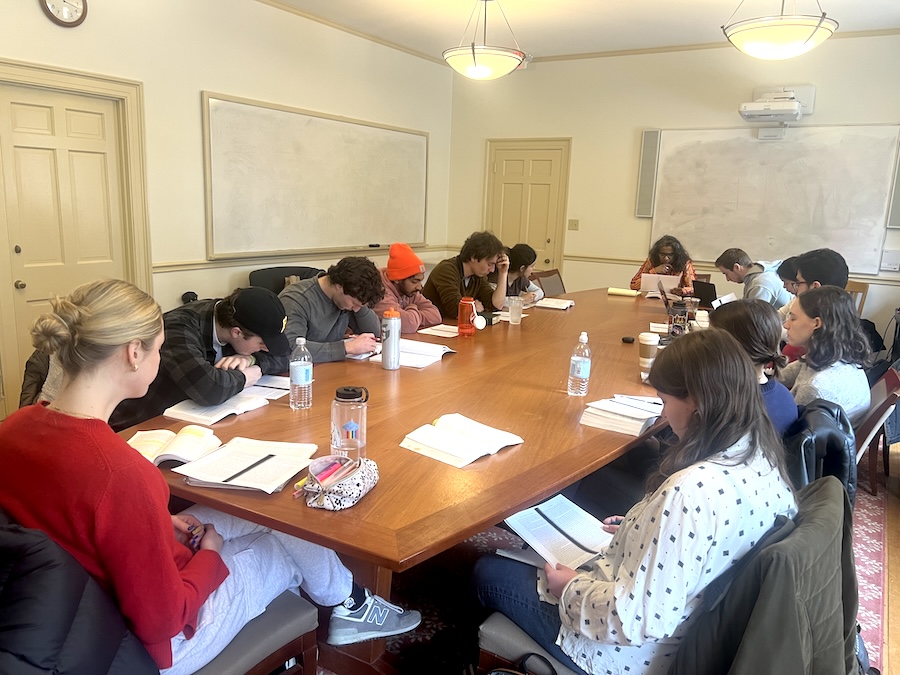
Idea Labs
Each Tuesday and Thursday this semester, a dozen students filed into a classroom to discuss the 1851 novel Moby-Dick and other novels by Herman Melville. They gathered in McKeen Study, a 224-year-old room with a fireplace and large, paned windows in Massachusetts Hall, the oldest building on campus.
On one of these mornings, the class focused on the character Pip, the Black cabin boy on Captain Ahab's whaling ship. Students opened hefty copies of Moby-Dick on the table they sat around, placing them next to various college staples like stickered water bottles, pens, and highlighters.
Only one student who had forgotten his novel brought out his laptop from time to time to check a passage in his digital version of the book. Other than an occasional appearance from his device, there were no phones, computers, or iPads in sight.
“Technology in my classes is strongly discouraged,” said Tess Chakkalakal. This semester, the associate professor of Africana studies and English taught a new English and Africana studies class, Herman Melville and Africa. She had students read Benito Cereno, Moby-Dick, and Billy Budd, as well as modern adaptations and analysis of each. Throughout the course, students considered the African sources of these stories.
- Africana Studies
- Art History
- Asian Studies
- Cinema Studies
- Classics
- English
- Environmental Studies
- Gender, Sexuality, and Women's Studies
- German
- History
- Latin American, Caribbean, and Latinx Studies (LACLaS)
- Music
- Middle Eastern and North African Studies (MENA)
- Philosophy
- Religion
- Romance Languages and Literatures
- Russian, East European, and Eurasian Studies (REEES)
- Theater and Dance
- Visual Arts
“Technology interferes with discussion,” she continued, explaining her tech policy. “If you have a screen in front of your face, you can’t talk to people, and you can’t listen to them by looking at them. Screens interfere with the simple task of having a conversation.”
While many professors across Bowdoin’s curriculum emphasize the importance of dialogue in their classes, the art of reading and connecting with other students sitting with you, with very few distractions in the room, is perhaps practiced in its purest form in humanities classes.
Emma Maggie Solberg, associate professor of English, makes it clear to her students—especially in her first-year writing seminars—that they are learning how to connect with one another even as they pore over medieval literature in her classes.
“I teach eye contact,” she said. To ensure that students look at and truly see one another, she delegates specific responsibilities to each student in every class session, with the most important being a single notetaker to free others to sit up and pay attention.







Chakkalakal compares her low-tech seminars to science labs; they are places for students to investigate concepts and alternative viewpoints, and to practice articulating them. She doesn’t mind when some students fumble their words or trail off mid-sentence.
“It’s the space where they’re experimenting with ideas, and it is trial and error,” she said. “And they should be allowed to make mistakes and start again, and start the conversation over again, or say, ‘I said that, and it’s not what I meant at all.’ That is what you do in conversation, you’re thinking out loud. That struggle is very positive.”
Part of the reason conversations can be challenging in humanities classes is that students are grappling with ambiguity and uncertainty, faculty say. Humanities classes often dwell on passages in books, scenes in movies, episodes in history, or ethical dilemmas that are open to interpretation, without clear answers.
“Students have to be comfortable with the fact that things aren’t clear, and yet you still have to figure out what is the best way to proceed,” Professor of History Dallas Denery said. “I think it is great for students to deal with uncertainty and ambiguity and to develop the tools to figure out the way to go forward—which could be interpreting a complicated book or unraveling a philosophical question. And they may never have answers.”
Texts as Teachers
While engaging with classmates is a critical component of every humanities class, the VIP in the room is usually the book students are reading. (Solberg said it’s so important to her that students read printed books rather than digital ones that she is thinking about applying for a grant to buy her students hard copies of books that they’ll return at the end of the semester.)
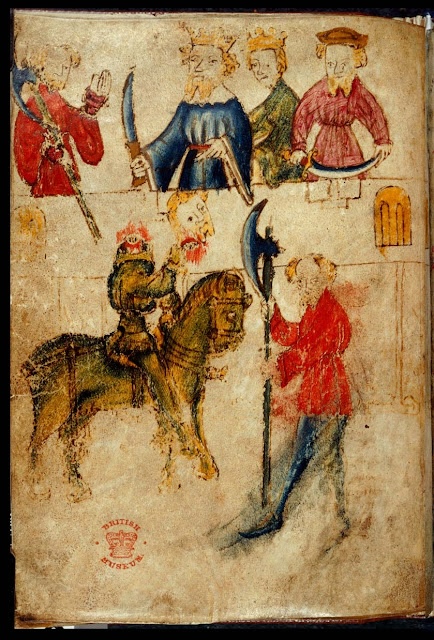
One of Solberg’s favorite stories to teach, and one beloved by her students, is Sir Gawain and the Green Knight, an epic poem from late fourteenth-century England. It is written in Middle English, so students are confronted with sentences that look quite foreign, such as, “Siþen þe sege and þe assaut watz sesed at troye...” (which, rougly translated, means, "When the siege and the assault had ceased at Troy...").
Despite this obstacle, by the end of the semester Solberg’s students are fluidly reading the antiquated language. Solberg finds this transformation significant. “We talk a lot about this: Everyone in the room starts out equally ignorant…and we all have to confront that ignorance every time we meet together.”
“I love that,” she continued. “There are no pretensions. All of us face our ignorance together with humility and learn something that is hundreds of years old and is quite dead. It is very dead, deader than dead, so old and so dead! And yet, it’s not dead by the end of the semester for the students.”
Plus, the trial of Sir Gawain, a knight tested by unsolvable riddles and insurmountable games who fails over and over because he’s an obsessive perfectionist, resonates with Bowdoin students. “I can’t tell you how many students cry in my office hours because they identify so much with Sir Gawain,” Solberg said.
Chakkalakal dedicated a class to Melville this spring because she believes that to better grasp the complexity of the United States, you should know its literature. “Moby-Dick is a classic American text; it has become part of American culture, and if you want to understand the United States, you should read it and see what you learn.”
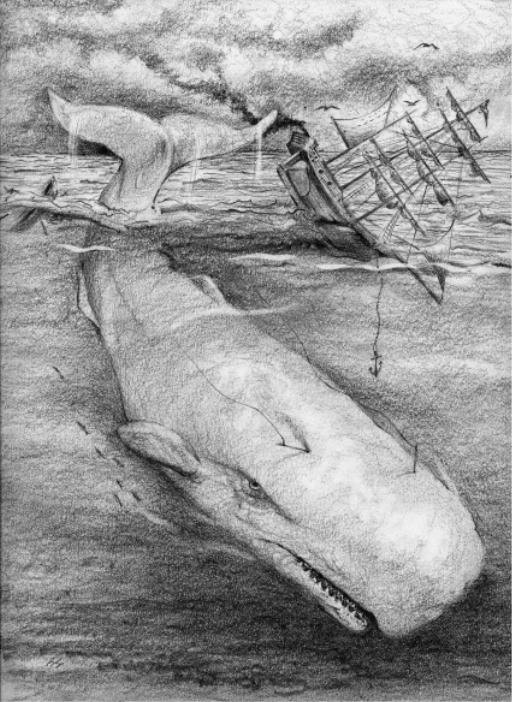
A student in her Melville class, Edmundo Ortiz Alvarez ’23, said he signed up because, for one, he adores Chakkalakal’s classes for their lively discussions, and two, “Because I think we should read good books, like Moby-Dick, with the purpose of learning how to live our lives better.”
As an English and philosophy major, Ortiz said he’s committed to reading and talking about books as part of figuring out how to be in this world. In other words, he’s a humanities diehard. “Approaching things with nuance is what I get from good books,” he said. As for Moby-Dick in particular, “I think, if anything, I derive from the book a sense of the complexity of a human.”
Another student in the class, Olivia Rayis ’24, said she’s been inspired by the harpooner Queequeg, who “lives a life that gives back to people and who does things for the sake of goodness and not for selfish motives. That is how the lessons of the book are applicable to my life.” Plus, like Ortiz, she enjoys Chakkalakal's class discussions, which are famously engaging and provocative. “We need discourse and debate. We can't just live in an echo chamber,” she pointed out.
By reading and discussing books, Rayis added, “You learn about the mechanisms and themes behind why your life is the way it is and how the world works. This allows me to move forward and to understand and to break out of the systems.”
The Good Life
About ten years ago, Denery created a new class called The Good Life. (Ortiz has taken it.) “It struck me that this is the kind of course a student who comes to a liberal arts college wants to take,” Denery said. “It seems to me you want to read books about making your life better.”
The conversations in his Good Life class quickly get interesting, and perplexing. “You ask a simple question like, ‘What does it mean to lead a good life’?” Denery said. “Some people will say they want to be happy, but then you ask, what does it mean to be happy?”
Often, Denery will ask students how many of them know somebody who is taking anti-anxiety medicine. “Every single student raises their hand,” he said. “That is a sign that is something wrong… We have long discussions about how we got to this point, where the things stopping people from leading a good life are anxiety and depression.”
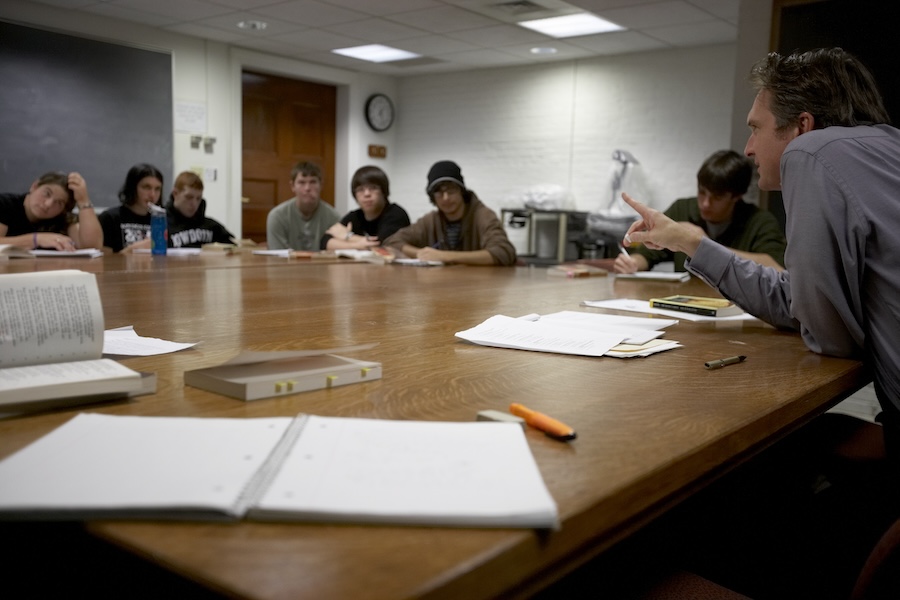
One of the books he assigns is The Burnout Society, by Byung-Chul Han, a Korean-born German philosopher. Han argues that our digital lives today are contributing to widespread maladies, including attention-deficit disorder and depression.
“He wants us to find spaces where we can just think,” Denery said. “His whole take is that the TikTok scroll, where you keep doing this”—at this, Denery flicks his index finger up, mimicking someone transfixed by a social media feed. “There is no end to it, but you think you need to keep doing it, and that is where anxiety comes along.”
TikTok, Instagram, Facebook—these are like distorted, demented versions of narratives, fueling an uneasy sense of something incomplete, according to Denery. “Scrolling media feeds is an activity that doesn’t have a finish,” he said. “There is no end to it, but you think you need to keep doing it, and that is where anxiety comes along—it’s activity without fulfillment.”







What about Beauty?
When students cross the doorway into a humanities class at Bowdoin, they often have a chance to take a reprieve from social media, screens, and technology. In the space that opens up, they have time to focus on writing, cinema, dance, theater, the arts, or even‚ at least this semester, Chinese calligraphy.
Professor of Asian Studies and Cinema Studies Shu-chin Tsui decided to teach a new course this spring, Brush and Ink: The Art of Writing and Painting via Calligraphy. It filled up fast. “It is the art of writing, the art of painting,” she said. “We so often address social-political issues in humanities classes, but what about beauty?”
As her students learned about the history and cultural importance of calligraphy in China, they also practiced the art in class. This activity, Tsui said, promotes, “self-cultivation and self-meditation.” In other words, it may provide that break that Denery spoke of, and open a space for reflection.
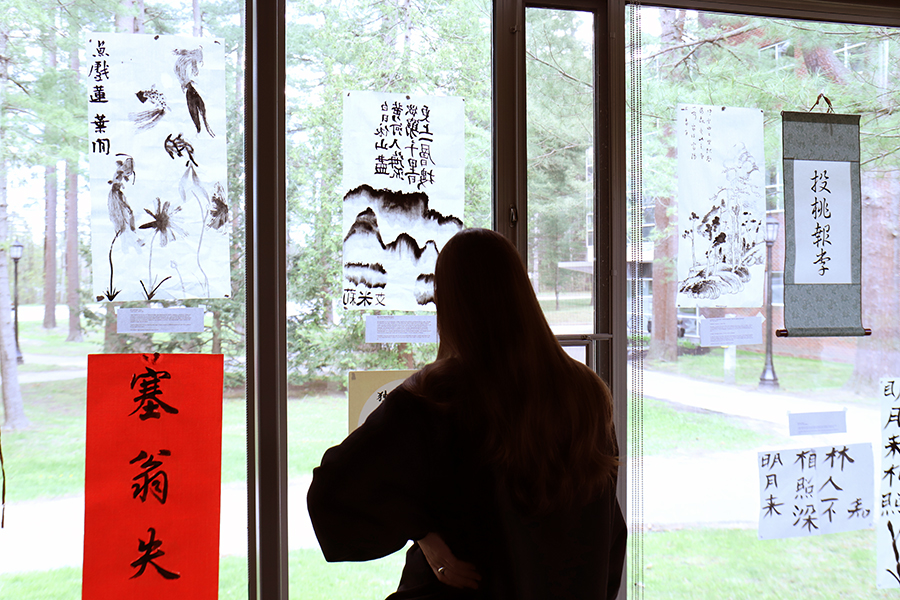
Chinese Calligraphy is just one of many courses Tsui teaches. Last semester, she offered a popular class on Asian American Cinema, and other years she has taught Going Viral: The Cinema of Pandemics, China’s Cultural Revolution through Film, and Ecocinema: China's Ecological and Environmental Crisis
Tsui has a creative take on the humanities, which is of course, the study of humanity, of people. But she believes the study of humanities should also include what lies beyond the boundary of our humanness.
For instance, her Ecocinema class “takes students to the edge of humanity,” the film scholar said. “We need to learn the interconnections between human and nonhuman—like the environment, air, viruses, other species, trash, everything that is not human. I say, ‘Hey, dear students, we are not at the center, we need to learn the world beyond us.”
Her recent manuscript, Ecological and Environmental Turns, which is in the final process of publication, calls for humanist scholars to make stronger connections between the humanities and the nonhuman world. “If we don’t have that consciousness beyond humanity, we are doomed,” she said.
After all, this is not an odious task. “I am inspired by bridging and connecting, that is my definition of humanities,” she continued. “You can’t sit here and say, ‘I am the center, you come to me.’ That mentality does not work. And, this approach can be beautiful, actually, very rewarding, constructive, and productive.”
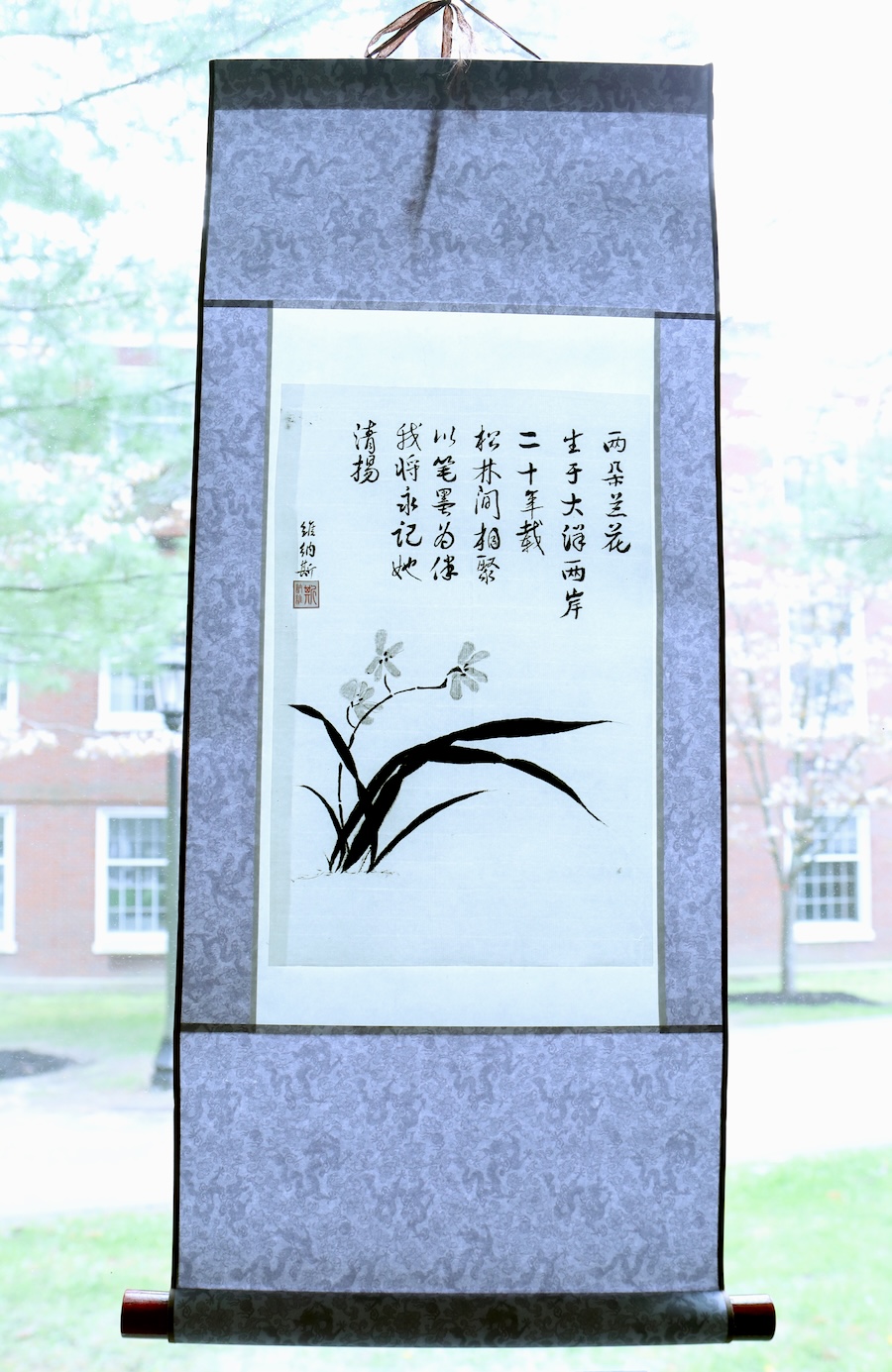 Two Orchids Across the Ocean, by Yanevith Pena ’25.
Two Orchids Across the Ocean, by Yanevith Pena ’25.
Pena had no experience in Chinese language or calligraphy before the class, and her painting and poem (below) are beautiful according to classic standards, said Tsui. They are dedicated to K Zhan ’25, who was a teaching assistant in Tsui's calligraphy class. She died in March.
In remembrance of K Zhan, an original poem
Two orchids born on different sides of the ocean
Twenty years later, come together surrounded by pine trees
With brush and ink
I will remember her
K Zhan